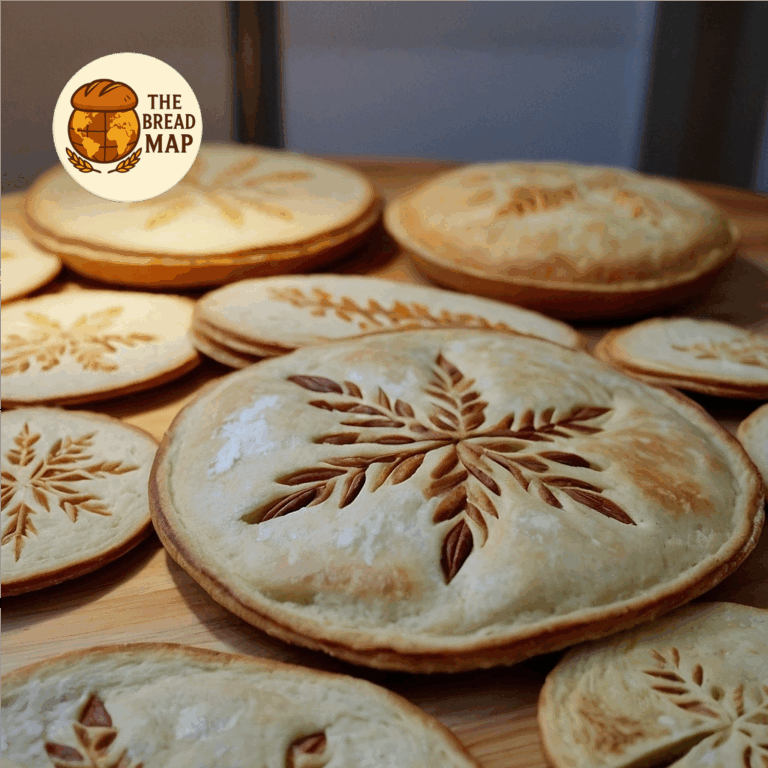
Laufabrauð, or “leaf bread,” is one of Iceland’s most cherished holiday indulgences—both for its crisp, golden flavor and its intricate, snowflake-like designs. This festive bread, as ephemeral as winter and as permanent as memory, is not just eaten but experienced. Every December, Icelandic families gather in kitchens to press, fold, and cut their artistic visions into these delicate discs before frying them into golden beauty. What emerges is both ornament and offering—a bread that symbolizes the artistic spirit and close-knit culture of Iceland.
Historical Background
The tradition of Laufabrauð dates back to at least the 18th century, though its exact origins are hard to pinpoint. In historical Iceland, where resources were scarce and winters long, luxury items like wheat were saved for special occasions. Making Laufabrauð became a way for families to celebrate Christmas with something meaningful yet economical—transforming a small amount of dough into decorative, edible works of art.
Back then, each region and even each household developed its own signature cutting patterns, often passed down through generations. The bread was originally baked on hot stones or over embers, but today it is typically fried, giving it its signature crisp texture and golden hue.
Region of Origin
Laufabrauð is found across Iceland, but it is especially prominent in the northern and western regions. In these colder, remote locales, where preserving family customs remains central to daily life, the preparation of Laufabrauð is often part of wider seasonal gatherings. While technology and modern convenience have simplified many aspects of Icelandic life, the ritual of making Laufabrauð endures—often accompanied by traditional music, storytelling, and plenty of laughter.
Ingredients and Preparation
Despite its elaborate look, Laufabrauð is made with a simple set of pantry staples. What makes it special is what happens after the dough is rolled out—when creativity takes over.
- Flour – Usually white wheat flour, finely milled
- Milk or Water – Used to moisten and bind the dough
- Butter or Margarine – Adds a subtle richness and helps with the crisping process
- Sugar and Salt – Optional, for a touch of flavor balance
The dough is rolled out extremely thin—almost translucent—and then cut into circles about the size of a plate. Using small knives, scallop wheels, or traditional Laufabrauð irons, each piece is then carved with symmetrical, nature-inspired patterns meant to resemble leaves, snowflakes, or even stars. These detailed designs are not only beautiful, but allow the bread to fry evenly and become wonderfully crisp. It’s important that the oil is hot and clean, ensuring the final product is light and golden rather than greasy.
Cultural Importance
At its heart, Laufabrauð is about connection—between people, generations, and the past. Making it is often a multi-generational activity, especially in rural households, where grandparents teach children the art of symmetrical cuts, telling stories of winters gone by. It’s one of the few Christmas prep activities that feels more celebratory than chore-like—even those who don’t usually bake find themselves drawn to the communal table, scissors or knife in hand, designing their own edible artwork.
Today, many Icelanders still make Laufabrauð at home, though pre-made versions can also be bought in shops. Still, few can resist the charm of crafting something by hand. The practice has earned it a place not just on the Christmas table, but in Iceland’s cultural heritage registry. Whether served on its own or alongside a traditional Christmas meal—often including smoked lamb or hangikjöt—Laufabrauð remains a crisp reminder that sometimes, the simplest ingredients create the most lasting memories.
In every cut, fold, and fry, Laufabrauð offers a glimpse into the Icelandic soul: resilient, artistic, close to nature, and deeply rooted in tradition.
Leave a Reply